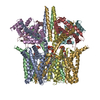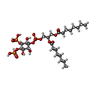+ Open data
Open data
- Basic information
Basic information
| Entry | Database: PDB / ID: 9lj5 | |||||||||||||||||||||
|---|---|---|---|---|---|---|---|---|---|---|---|---|---|---|---|---|---|---|---|---|---|---|
| Title | Human KCNQ5-CaM-PIP2-HN37 complex in an open conformation. | |||||||||||||||||||||
 Components Components |
| |||||||||||||||||||||
 Keywords Keywords | MEMBRANE PROTEIN / voltage-gated potassium channel | |||||||||||||||||||||
| Function / homology |  Function and homology information Function and homology informationclathrin coat / transporter inhibitor activity / voltage-gated monoatomic ion channel activity involved in regulation of presynaptic membrane potential / Voltage gated Potassium channels / establishment of protein localization to mitochondrial membrane / type 3 metabotropic glutamate receptor binding / response to corticosterone / negative regulation of high voltage-gated calcium channel activity / negative regulation of calcium ion export across plasma membrane / regulation of cardiac muscle cell action potential ...clathrin coat / transporter inhibitor activity / voltage-gated monoatomic ion channel activity involved in regulation of presynaptic membrane potential / Voltage gated Potassium channels / establishment of protein localization to mitochondrial membrane / type 3 metabotropic glutamate receptor binding / response to corticosterone / negative regulation of high voltage-gated calcium channel activity / negative regulation of calcium ion export across plasma membrane / regulation of cardiac muscle cell action potential / presynaptic endocytosis / nitric-oxide synthase binding / regulation of cell communication by electrical coupling involved in cardiac conduction / regulation of synaptic vesicle exocytosis / calcineurin-mediated signaling / adenylate cyclase binding / protein phosphatase activator activity / voltage-gated potassium channel activity / detection of calcium ion / regulation of synaptic vesicle endocytosis / regulation of cardiac muscle contraction / catalytic complex / postsynaptic cytosol / regulation of cardiac muscle contraction by regulation of the release of sequestered calcium ion / phosphatidylinositol 3-kinase binding / presynaptic cytosol / regulation of release of sequestered calcium ion into cytosol by sarcoplasmic reticulum / titin binding / sperm midpiece / regulation of calcium-mediated signaling / voltage-gated potassium channel complex / potassium ion transmembrane transport / calcium channel complex / substantia nigra development / regulation of heart rate / calyx of Held / response to amphetamine / adenylate cyclase activator activity / sarcomere / protein serine/threonine kinase activator activity / nitric-oxide synthase regulator activity / regulation of cytokinesis / spindle microtubule / calcium channel regulator activity / response to calcium ion / mitochondrial membrane / G2/M transition of mitotic cell cycle / Schaffer collateral - CA1 synapse / long-term synaptic potentiation / spindle pole / calcium-dependent protein binding / synaptic vesicle membrane / myelin sheath / presynaptic membrane / growth cone / vesicle / transmembrane transporter binding / G protein-coupled receptor signaling pathway / protein domain specific binding / calcium ion binding / centrosome / protein kinase binding / protein-containing complex / nucleus / plasma membrane / cytoplasm Similarity search - Function | |||||||||||||||||||||
| Biological species |  Homo sapiens (human) Homo sapiens (human) | |||||||||||||||||||||
| Method | ELECTRON MICROSCOPY / single particle reconstruction / cryo EM / Resolution: 2.9 Å | |||||||||||||||||||||
 Authors Authors | Yang, Z. / Guo, J. | |||||||||||||||||||||
| Funding support |  China, 1items China, 1items
| |||||||||||||||||||||
 Citation Citation |  Journal: Proc Natl Acad Sci U S A / Year: 2025 Journal: Proc Natl Acad Sci U S A / Year: 2025Title: Phosphatidylinositol 4,5-bisphosphate activation mechanism of human KCNQ5. Authors: Zhenni Yang / Yueming Zheng / Demin Ma / Long Wang / Jiatong Zhang / Tiefeng Song / Yong Wang / Yan Zhang / Fajun Nan / Nannan Su / Zhaobing Gao / Jiangtao Guo /  Abstract: The human voltage-gated potassium channels KCNQ2, KCNQ3, and KCNQ5 can form homo- and heterotetrameric channels that are responsible for generating the neuronal M current and maintaining the membrane ...The human voltage-gated potassium channels KCNQ2, KCNQ3, and KCNQ5 can form homo- and heterotetrameric channels that are responsible for generating the neuronal M current and maintaining the membrane potential stable. Activation of KCNQ channels requires both the depolarization of membrane potential and phosphatidylinositol 4,5-bisphosphate (PIP). Here, we report cryoelectron microscopy structures of the human KCNQ5-calmodulin (CaM) complex in the apo, PIP-bound, and both PIP- and the activator HN37-bound states in either a closed or an open conformation. In the closed conformation, a PIP molecule binds in the middle of the groove between two adjacent voltage-sensing domains (VSDs), whereas in the open conformation, one additional PIP binds to the interface of VSD and the pore domain, accompanying structural rearrangement of the cytosolic domain of KCNQ and CaM. The structures, along with electrophysiology analyses, reveal the two different binding modes of PIP and elucidate the PIP activation mechanism of KCNQ5. | |||||||||||||||||||||
| History |
|
- Structure visualization
Structure visualization
| Structure viewer | Molecule:  Molmil Molmil Jmol/JSmol Jmol/JSmol |
|---|
- Downloads & links
Downloads & links
- Download
Download
| PDBx/mmCIF format |  9lj5.cif.gz 9lj5.cif.gz | 751.4 KB | Display |  PDBx/mmCIF format PDBx/mmCIF format |
|---|---|---|---|---|
| PDB format |  pdb9lj5.ent.gz pdb9lj5.ent.gz | 629.7 KB | Display |  PDB format PDB format |
| PDBx/mmJSON format |  9lj5.json.gz 9lj5.json.gz | Tree view |  PDBx/mmJSON format PDBx/mmJSON format | |
| Others |  Other downloads Other downloads |
-Validation report
| Arichive directory |  https://data.pdbj.org/pub/pdb/validation_reports/lj/9lj5 https://data.pdbj.org/pub/pdb/validation_reports/lj/9lj5 ftp://data.pdbj.org/pub/pdb/validation_reports/lj/9lj5 ftp://data.pdbj.org/pub/pdb/validation_reports/lj/9lj5 | HTTPS FTP |
|---|
-Related structure data
| Related structure data |  63133MC  9j38C  9lizC  9lj1C M: map data used to model this data C: citing same article ( |
|---|---|
| Similar structure data | Similarity search - Function & homology  F&H Search F&H Search |
- Links
Links
- Assembly
Assembly
| Deposited unit | 
|
|---|---|
| 1 |
|
- Components
Components
| #1: Protein | Mass: 70463.289 Da / Num. of mol.: 4 Source method: isolated from a genetically manipulated source Source: (gene. exp.)  Homo sapiens (human) / Gene: KCNQ5 / Cell line (production host): HEK293 / Production host: Homo sapiens (human) / Gene: KCNQ5 / Cell line (production host): HEK293 / Production host:  Homo sapiens (human) / References: UniProt: Q9NR82 Homo sapiens (human) / References: UniProt: Q9NR82#2: Protein | Mass: 19615.445 Da / Num. of mol.: 4 Source method: isolated from a genetically manipulated source Source: (gene. exp.)  Homo sapiens (human) / Gene: CALM3, CALML2, CAM3, CAMC, CAMIII / Cell line (production host): HEK293 / Production host: Homo sapiens (human) / Gene: CALM3, CALML2, CAM3, CAMC, CAMIII / Cell line (production host): HEK293 / Production host:  Homo sapiens (human) / References: UniProt: P0DP25 Homo sapiens (human) / References: UniProt: P0DP25#3: Chemical | ChemComp-PIO / [( #4: Chemical | ChemComp-9MF / Has ligand of interest | Y | Has protein modification | N | |
|---|
-Experimental details
-Experiment
| Experiment | Method: ELECTRON MICROSCOPY |
|---|---|
| EM experiment | Aggregation state: PARTICLE / 3D reconstruction method: single particle reconstruction |
- Sample preparation
Sample preparation
| Component | Name: Human KCNQ5-CaM-PIP2-HN37 complex / Type: COMPLEX / Entity ID: #1-#2 / Source: RECOMBINANT |
|---|---|
| Source (natural) | Organism:  Homo sapiens (human) Homo sapiens (human) |
| Source (recombinant) | Organism:  Homo sapiens (human) / Cell: hek 293 Homo sapiens (human) / Cell: hek 293 |
| Buffer solution | pH: 8 |
| Specimen | Embedding applied: NO / Shadowing applied: NO / Staining applied: NO / Vitrification applied: YES |
| Vitrification | Cryogen name: ETHANE |
- Electron microscopy imaging
Electron microscopy imaging
| Experimental equipment |  Model: Titan Krios / Image courtesy: FEI Company |
|---|---|
| Microscopy | Model: TFS KRIOS |
| Electron gun | Electron source:  FIELD EMISSION GUN / Accelerating voltage: 300 kV / Illumination mode: FLOOD BEAM FIELD EMISSION GUN / Accelerating voltage: 300 kV / Illumination mode: FLOOD BEAM |
| Electron lens | Mode: BRIGHT FIELD / Nominal defocus max: 1600 nm / Nominal defocus min: 800 nm / Cs: 2.7 mm |
| Image recording | Electron dose: 52 e/Å2 / Film or detector model: GATAN K2 QUANTUM (4k x 4k) |
- Processing
Processing
| CTF correction | Type: PHASE FLIPPING AND AMPLITUDE CORRECTION |
|---|---|
| 3D reconstruction | Resolution: 2.9 Å / Resolution method: FSC 0.143 CUT-OFF / Num. of particles: 244993 / Symmetry type: POINT |
 Movie
Movie Controller
Controller






 PDBj
PDBj



